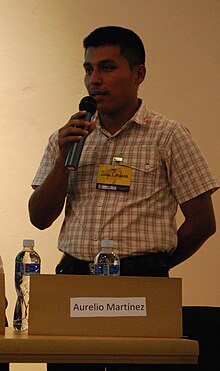|
Languages of Honduras
There are a number of languages spoken in Honduras though the official language is Spanish. Languages spoken in HondurasIn Honduras, dozens of languages were spoken before the Spanish conquest. The language most spoken was the language; after the conquest, the most spoken language became Castilian. SpanishBy far, Spanish is the most widely spoken language in the country, spoken natively by the vast majority of citizens, regardless of ethnicity. Honduran Spanish is considered a variety of Central American Spanish. Honduran Sign LanguageLencaThe language of the Honduran Lencas is considered an extinct language. Because it is already in danger of extinction, it has a population of 300 to 594 semi-speakers. Its geographical location is between the western departments of Honduras, as they are: Lempira, Intibucá, La Paz, also they are in smaller quantity in the central departments of Santa Barbara, Comayagua Department, Francisco Morazán Department and Valle. Ch’orti’ languageThe Chʼortiʼ people speak a Mayan language in the Ch'olan group. Garifuna languageThey are the result of the mixture of African slaves (that shipwrecked in two ships in 1655 and another one that shipwrecked in 1675) with the Caribbean Indians (Amerindians, who had diverse languages called Caribbean languages), thus originated the Black Caribs who dominated the Island of Saint Vincent and the Grenadines until 1797, when they were expelled by the English towards Roatán and Trujillo. Bay Islands EnglishThe Bay Islands are composed of larger islands called Utila, Roatan and Guanaja and their smaller islands or islets called Morat, Barbareta, Santa Elena and Cayos Cochinos. They are located on the northern coast of Honduras. Their language is Creole English. Imported from England and Ireland, when the pirates and corsairs possessed these lands, when they attacked the ships of the Spanish Empire. Tawahka or sumo language According to studies consulted, the Tawahka language and the Misquita are quite similar in their morphological and syntactic structure, although they do not have much lexicon in common. Both languages belong to the group macro-chibcha, linguistic group of South American origin. It is assumed that in very distant dates the ancestors of the Tawahkas, Misquitos and the branches (another related group), emigrated from what is now Colombia passing through the isthmus of Panama. The Tawahkas call their language Twanka, which shows a similarity to the name that, at the beginning of the seventeenth century, the Spaniards gave the Indians of the Guayape-Guayambre area: tahuajcas. The mother tongue of this town is Tawahka, but they also speak Miskito and Spanish, although they still have some difficulty speaking Spanish. Tolupan languagePaya languageThey call themselves "pech" which means "people," a term that is used to refer only to them; for the rest of the population they use the terms pech-akuá (the other people) or bulá that means ladino. Lehmann and Greenberg consider that the pech language comes from the chibcha, although some linguists consider it an isolated league. MiskituThe Miskitos are a mixed-race ethnic group with their own language, occupying part of the territory of Honduras and Nicaragua. Matagalpa languageIt is an extinct language of the Misumalpan languages that was the main language of the central highlands of the republic of Nicaragua and of the department of El Paraíso in The Republic of Honduras. In El Paraíso, it was called the language of the "Chatos" and "Sules" of that Honduran department. ClassificationHondurans, as mentioned, are usually classified into six language families. Some of the languages are poorly documented, however, it seems that all languages documented in Honduras can be classified with reasonable certainty. Some of the languages are currently extinct (and here they are marked with the sign †). The table indicates the territories where the different languages were spoken, although in the actulidad the languages have disappeared of many of the indicated departments. The following list contains 12 languages between living languages and extinct languages:
See also
External links
|
|||||||||||||||||||||||||||||||||||||||||||||||||||||||||||||||||||||||||||||
